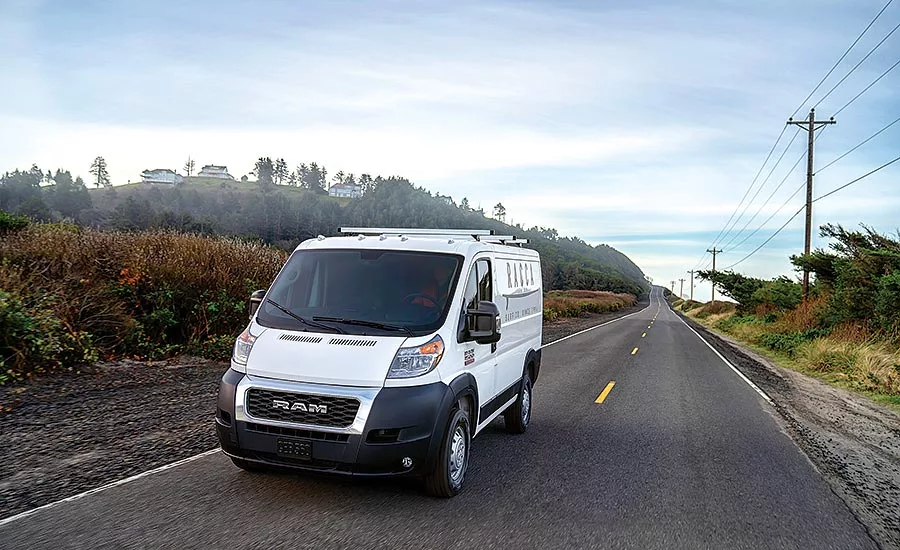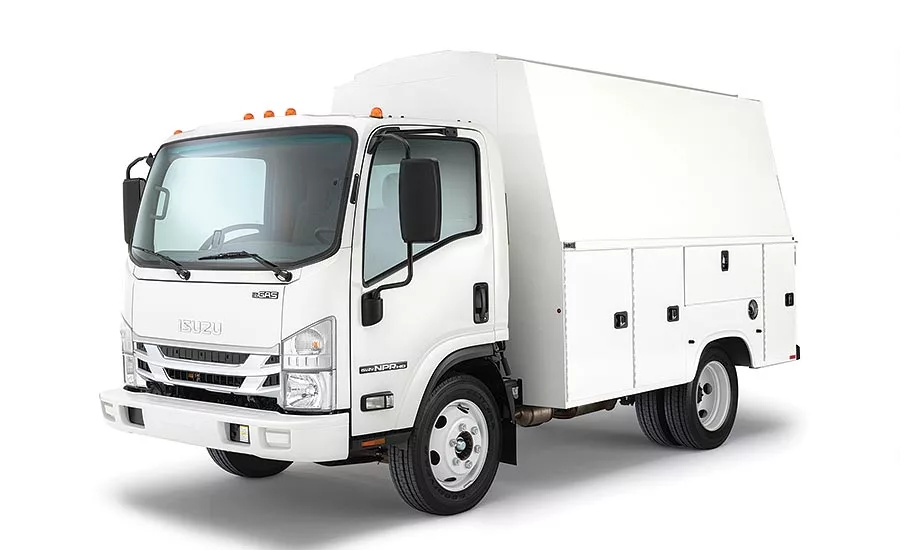Not your father’s work truck
High-tech safety features help contractors reduce liability risk.

The 2021 Ram ProMaster features a front-wheel-drive system, low step-in height, crosswind assist and multiple safety options, including blind-spot monitoring, rear cross path detection, forward collision warning and the brand new digital rearview mirror. Photo courtesy of Ram commercial.

Isuzu partnered with Knapheide to create the Isuzu Road Ready Body Program, which allows contractors to order the most popular body options directly from Isuzu. Photo courtesy of Isuzu commercial truck of America.
Perhaps one of the most critical parts of a plumbing and heating contractor’s business is its fleet. A company needs vehicles to get their technicians and installers from point A to point B. These trucks and vans take a beating — racking up miles as they haul tools and equipment from job to job. Therefore, it is essential that these vehicles operate at peak efficiency for many years.
According to Cary Shapiro, Ford brand manager, Transit and Transit Connect, service contractors are looking for flexibility and versatility.
“Today’s vans are so much more customizable than the vans of the past, and customers are taking advantage of the opportunity to design vehicles that work for them,” he says.
Dave Sowers, head of Ram Commercial, notes contracting companies are selecting vehicles that might be very different from what they’ve chosen in the past.
“Contractors today are trying to right-size their vehicles through the capabilities that are available in the marketplace,” he says. “We see some contractors who may have had heavier vehicles, like a Class 6 truck, that are now able to buy a Class 5 or smaller, which has lower costs of acquisition, lower cost of operation over time and allows them to get the same amount of work done that they were able to previously.
“We also see some contractors moving into the van space,” Sowers adds. “Full-size vans have become much more functional for contractors in the marketplace because we have European-style vans with higher roofs available, and it’s great for contractors to have that interior workspace. And vans of this type are able to achieve higher payload capacity as well.”
Hot features
Last year, Isuzu Commercial Truck of America partnered with Knapheide to offer a body program to its contracting clients, says Brian Tabel, executive director of marketing, Isuzu Commercial Truck of America.
“Having the serviceability, warranty and repairs all from one national body company is very beneficial, especially for our clients with a multitude of trucks all over the country,” he notes.
Tabel also points to the rearview camera as being the most asked-for feature by contractors.
“Contractors want a backup camera for safety reasons — helping to ensure their drivers see what is behind them and navigating around anything that might be there. Another thing that’s come into play is lane avoidance, something we introduced a couple of years ago. Safety features are becoming more of something people are requesting.
“Additionally, maneuverability is increasingly important,” he continues. “All our trucks are low-cab-forward, so very maneuverable with a tight turning radius — very important features for parking in neighborhoods or industrial parks.”
Sowers agrees, saying there is a significant demand for active safety features on commercial vehicles in the marketplace.
“We’ve made some significant investments in our truck and van lineups over the last couple of years to provide those types of features for those contractors,” he says. “Launching with our 2021 model year ProMaster van, which is probably our main vehicle of choice for people in the plumbing and mechanical trades, is collision mitigation, blind-spot monitoring and another feature called digital rear view mirror, which is unique in the marketplace. And those are all centered around safety.”
From the health and safety of employees to loss of productivity to out-of-pocket expenses to repair the vehicle, businesses see a significant liability with collisions and accidents in work vehicles.
“It’s very important for plumbing and mechanical contractors to protect their employees and their investments,” Sowers says. “And this is a way that they’re doing it today that they haven’t been in the past. When contractors hire employees, they’re hiring people with a specific skillset as it relates to plumbing, not necessarily driving. So they want these active safety features that increase visibility around the vehicle — anything to help make the commercial vehicle more drivable.”
According to Shapiro, the most popular features depend on the contractor’s location.
“Customers in the Northern climates where snow can be an issue are increasingly choosing all-wheel drive so they don’t have to slow down their business due to inclement weather,” he notes. “They’re asking for all-wheel drive to come without an increase in load height because they get in and out of the van so many times every day. For the same reason, they’re asking for better ergonomics to minimize the impact their vans have on their bodies. For this reason, we expect our new optional console with right-hand shifter to be very popular with this group because it provides more than 7 inches of additional leg room for the driver.
“Customer feedback also led to our replacing the manual parking brake in all Transit vans up to 9,500 pounds GVWR with an electronic parking brake,” he continues. “This change completely cleared the aisle between the front seats, making it easier for the driver to get to the cargo compartment without stepping outside the van. We’ve also made the overhead shelf optional for improved clearance when standing. Transit also gets a facelift for 2021 with a honeycomb mesh grille standard on all models, three new colors and new wheel choices.”
Efficiency and the move to electric vehicles
The main trend for efficiency today goes back to Sowers’ main point that contractors are right-sizing their vehicles.
“Buying that Class 2 van instead of a Class 5 truck gives them efficiency in terms of what they pay out of pocket up front and total cost of ownership over time,” he says. “And anytime you can buy one of those lesser vehicles, they’re inherently more efficient in terms of fuel economy and energy consumption.”
Sowers notes the electric trend across the automotive landscape will eventually make its way into the commercial lineup — but it’s not happening just yet.
“Electric vehicles can mean anything from hybrid to plug-in hybrid all the way to pure battery electric vehicles,” he explains. “All of those things are possible considerations [for commercial vehicles], and I do think that there is growing interest there. The main concerns with those vehicles at this time are the high cost of acquisition and also a range anxiety.”
Sowers adds adoption of electric vehicles will be slow and gradual, as most contractors won’t be able to upgrade their entire fleet with a new technology all at once.
“There are certainly a lot of benefits that come with the varieties of electrification,” he says. “And I think you’ll see some of those offerings coming into the marketplace, whether that’s driven by government regulation or by the contractor’s demand for those products.”
Electric vehicles absolutely have an important role to play in the service contractor market, according to Shapiro.
“Ford is investing more than $11.5 billion in electric vehicles through 2022, including the all-electric Transit coming for the 2022 model year and fully electric F-150,” he notes. “Electric vehicles offer contractors a number of advantages, including versatility, lower cost of operation and environmental benefits. Contractors can operate electric vehicles in areas where vehicles with internal combustion engines cannot go, such as indoors, in environments with limited ventilation and at night in areas with restrictive noise ordinances. They also require less scheduled maintenance and have lower overall operating costs than those with internal combustion engines.”
Tabel agrees electric vehicles will be a key factor for the future.
“In 2024, trucks will require a zero emission vehicle to operate in the state of California. So due to the limited mileage that most people are driving on a daily basis, electric pays off. But, on the other hand, without incentives or federal and state incentives, electric vehicles are expensive. The infrastructure is another thing that will play into it because, as more vehicles get on the road, the infrastructure will have to be there to support the electric demands of all the vehicles going into play.”
Market outlook
The commercial vehicle industry is certainly not immune to the impact of COVID-19; however, the market outlook remains opptomistic, Shapiro notes.
“Ford shut down vehicle production and switched over to manufacturing respirators, face masks, shields and other PPE for medical first responders early in the pandemic,” he says. “Since bringing vehicle manufacturing back online, demand has driven significant commercial vehicle sales. For example, sales of Transit vans in the third quarter were up 117% over the second quarter.”
Tabel notes Isuzu is down about 15% from the same time last year.
“Some industries are being hit more than others, specifically for contractors,” he says. “We’re seeing a definite steady business flow because things are still being broken and need to be fixed, but we’ve seen a bit of decline in construction.”
Sowers agrees, saying COVID-19 has impacted just about every part of all our lives.
“Initially, we saw a significant drop in demand when the lockdowns were in place,” he notes. “Many of these contractors couldn’t conduct their normal daily business, and because of that, they also weren’t purchasing vehicles. What we’re seeing is pent-up demand for the work for plumbing and contracting businesses — work that they were not able to conduct during the lockdowns. And they’ve got fresh new work as well, so there’s kind of a backlog.
“So COVID-19 has done both things — it has suppressed contractor demand during the second quarter, but that has really bounced back,” he adds.
“We expect the fourth quarter of the year to be very robust because of that continuing demand. You’re into the time of year when all of these companies are looking at the tax liabilities, and they have to make asset investments to offset some of the profit they’ve made throughout the year. It’s a big quarter, big time of the year for contractors. COVID-19 has made a big impact, but I think people are figuring a way to work around it.”
Looking for a reprint of this article?
From high-res PDFs to custom plaques, order your copy today!






